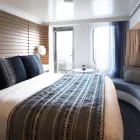- Ship
- 1 Breakfast, 1 Lunch, 1 Dinner
The legendary Cyclades island of Delos stands just a few miles southwest of Mykonos. The ceremonial solemnity of this ancient holy sanctuary does not leave you indifferent. The sheer size and importance of this UNESCO World Heritage site which covers over half of the island is thrilling in itself. From the Stoa of Antigonos, the Terrace of the Lions, to the carved marble animal statues, make discovery after discovery against a backdrop of the Aegean stretching to the horizon. The theater steps on the hillside are a particularly good place from which to enjoy the expansive view.
Optional Excursions:
The Archaeological Site of Delos - In ancient times, Delos was a major sacred site, second in importance only to the Temple of Apollo at Delphi. The island was covered in a variety of temples and sanctuaries dedicated to various gods. Today, it is a fascinating archaeological site located a short boat ride from the island of Mykonos. It is one of the best-preserved archaeological sites of Greece, the largest open-air site in Europe, and it is the oldest. In spite of its relatively small size, there are a lot of houses, temples, and sanctuaries to view. Start your tour with the Sacred Harbor on the west coast of the island. From the harbor at Delos, a majestic sacred way led to the Sanctuary of Apollo, where there were temples, altars, votive offerings and other buildings. There are ruins of four temples of Apollo, one known is the Temple of the Athenians.
Just near by, discover the Terrace of the Lions. Continue to the splendid mosaic floor of a building located in the Theatre Quarter, perhaps the most interesting part of the city, which includes streets, homes, workshops and above all, shops that serviced the very lively trade in Delos. The House of Dionysus, located in the Theatre Quarter, is a good example of a private residence dating from the last quarter of the 2nd century BCE. A covered passage leads from the entrance to an epistyle court, on which open the rooms of the ground floor. This is all walking tour. Wear comfortable walking shoes, a hat and sunglasses. The guide cannot do a guided visit to the museum.
Nicknamed “little Venice”, Mykonos is famous for its Alefkandra district where houses are built right on the water’s edge. Their multi-colored loggias are emblematic of this Cyclades island, as are the pelicans and windmills. You can get close up to the birds on the quaysides of the old port. Up on the hillside, you can see the windmill sails turning. In the cobbled streets of the pedestrian center, bougainvillea bedeck immaculate facades. As you weave in and out of the little streets, snatches of coastline undoubtedly call you to the island’s beaches, the quietest of which can be found on the northern coast.
Optional Excursions:
Jeep Adventure - After disembarkation pick up your jeep to begin your adventure, driving through the island’s rugged terrain on a tour that takes you to an old lighthouse. From here continue to Fragma and Agios Ioannis from where you can see Delos island in the distance. As you follow the road to Kalo Livadi, there is a stunning view of rugged rocks and cliffs on both sides, before reaching Ano Mera where snacks and refreshments are served in the peaceful village square. Then, take the road back to your ship.


























